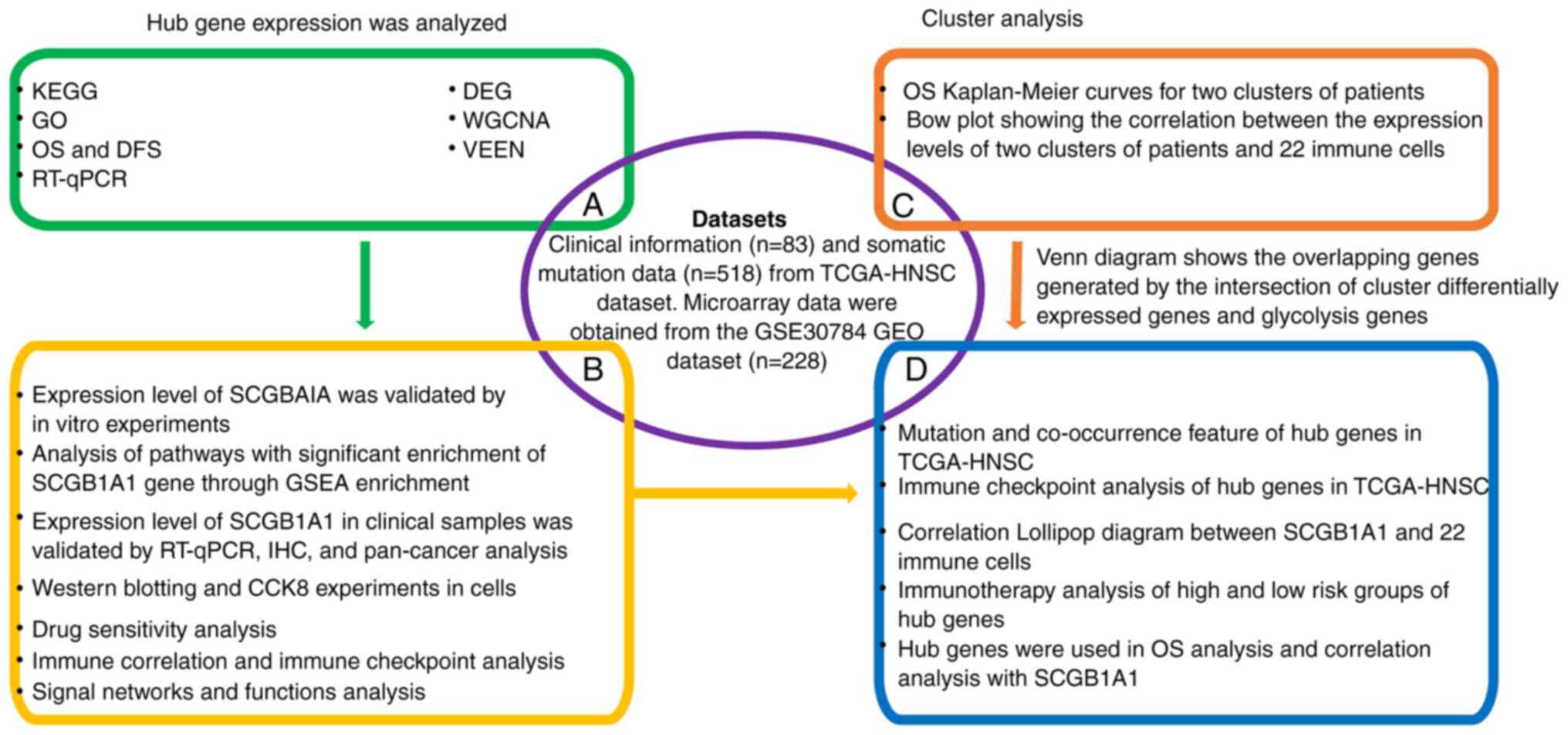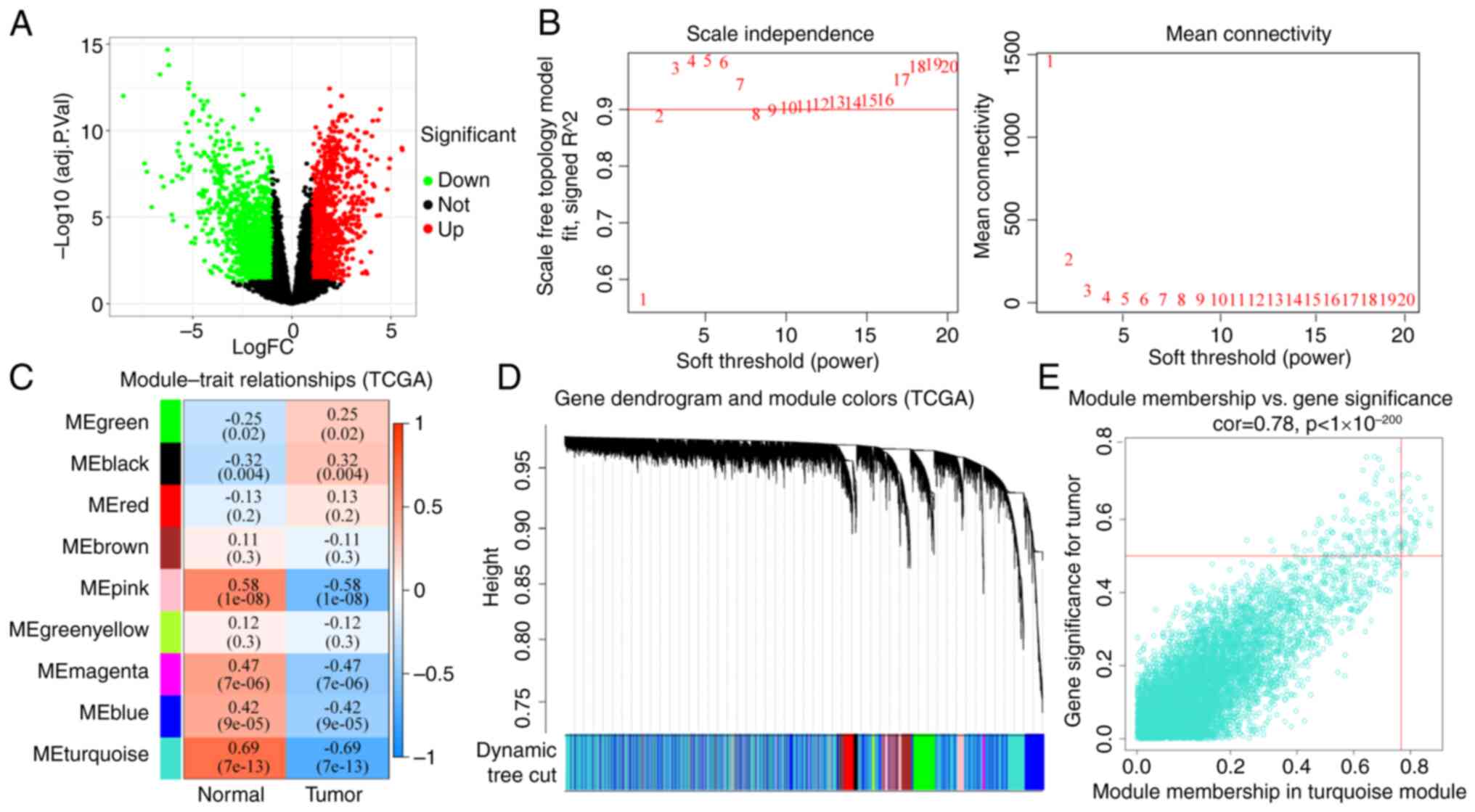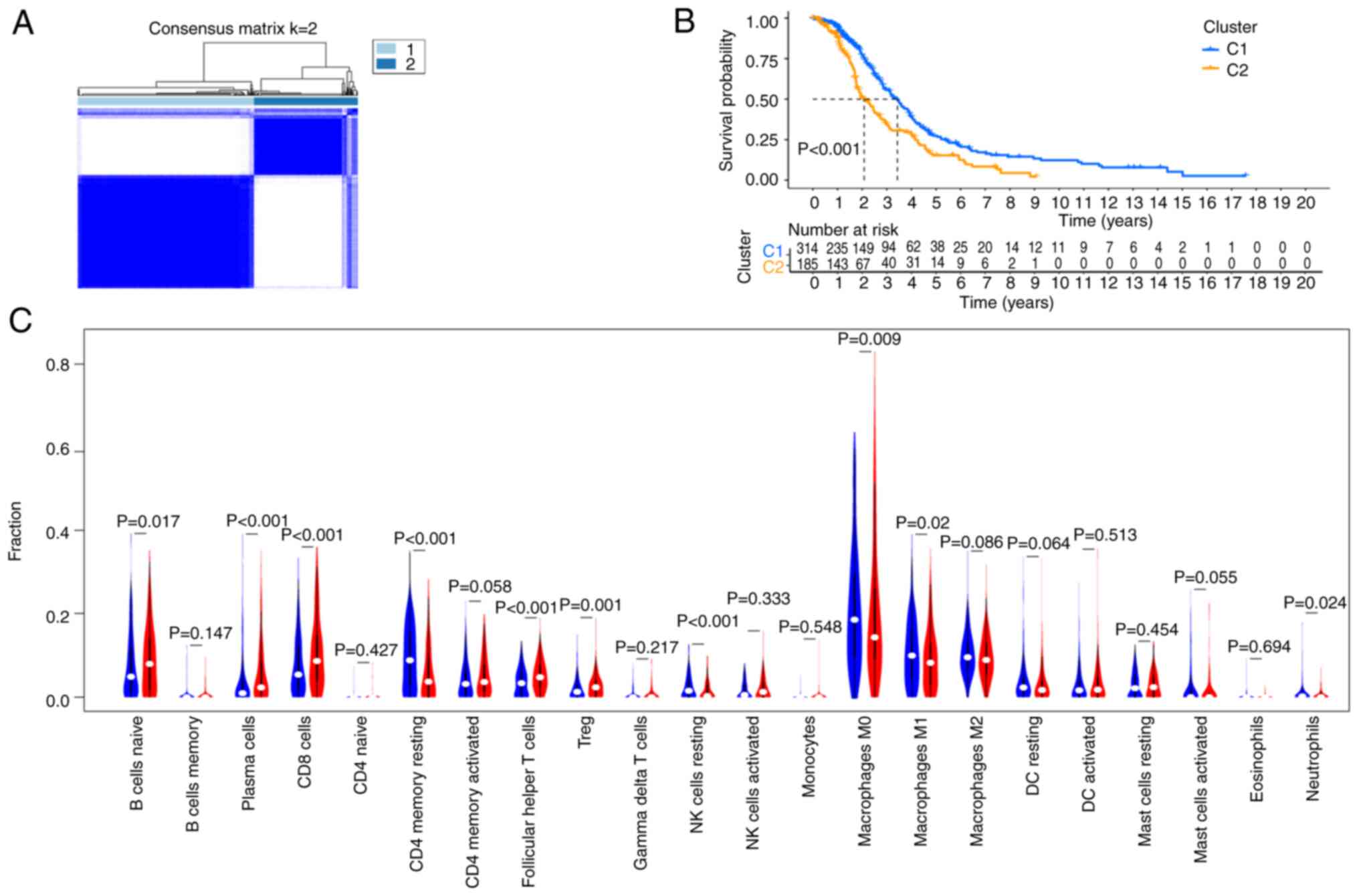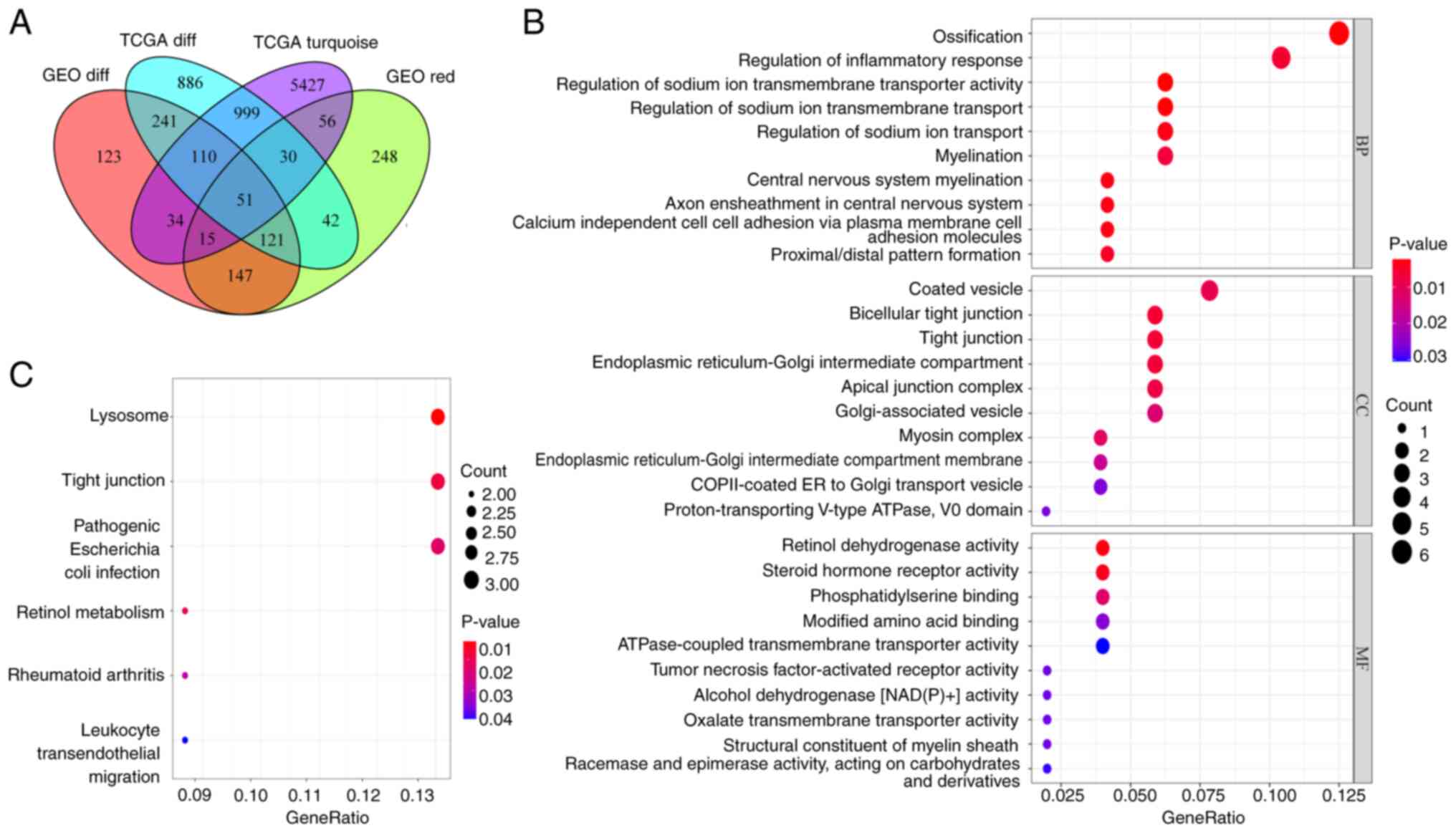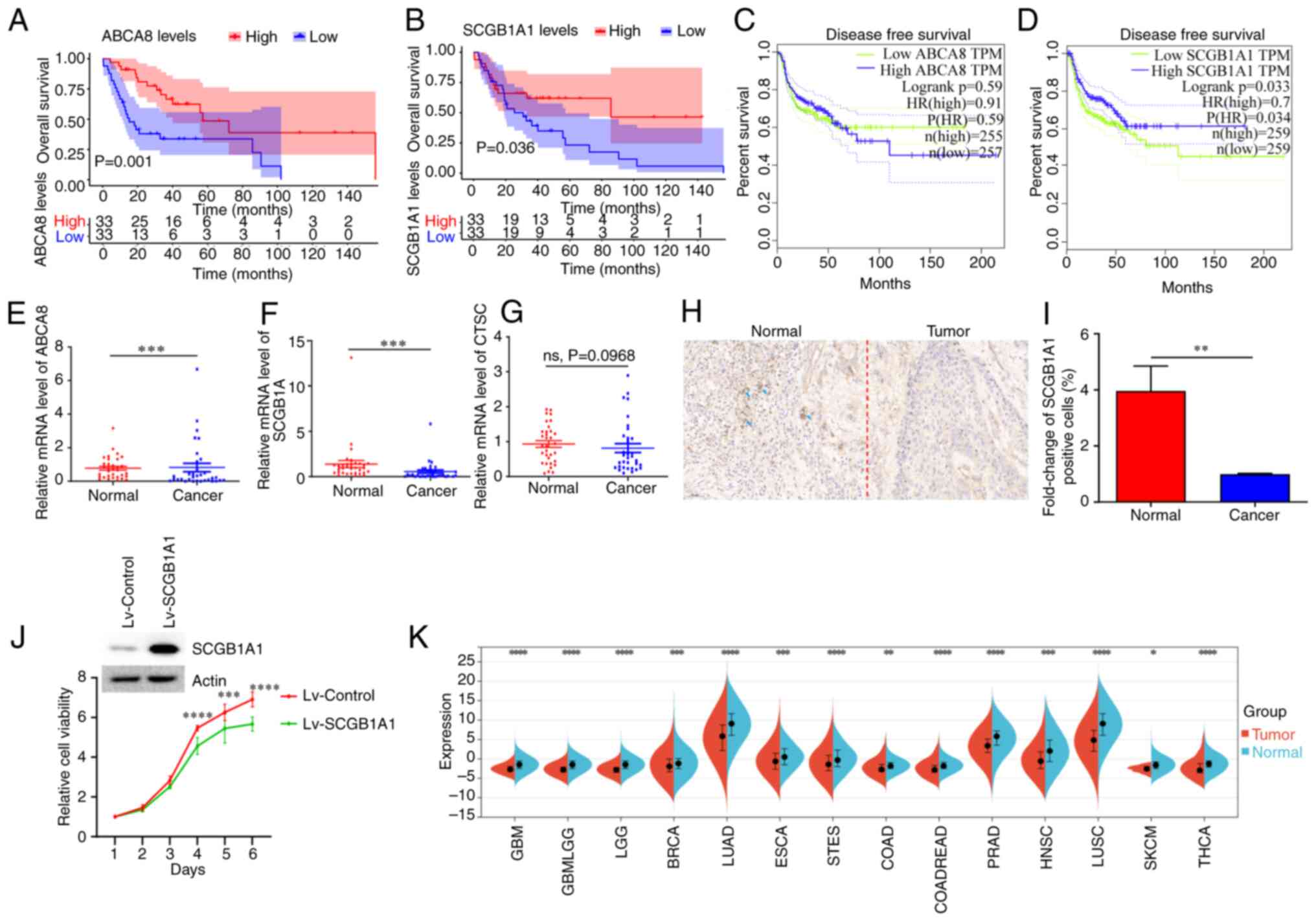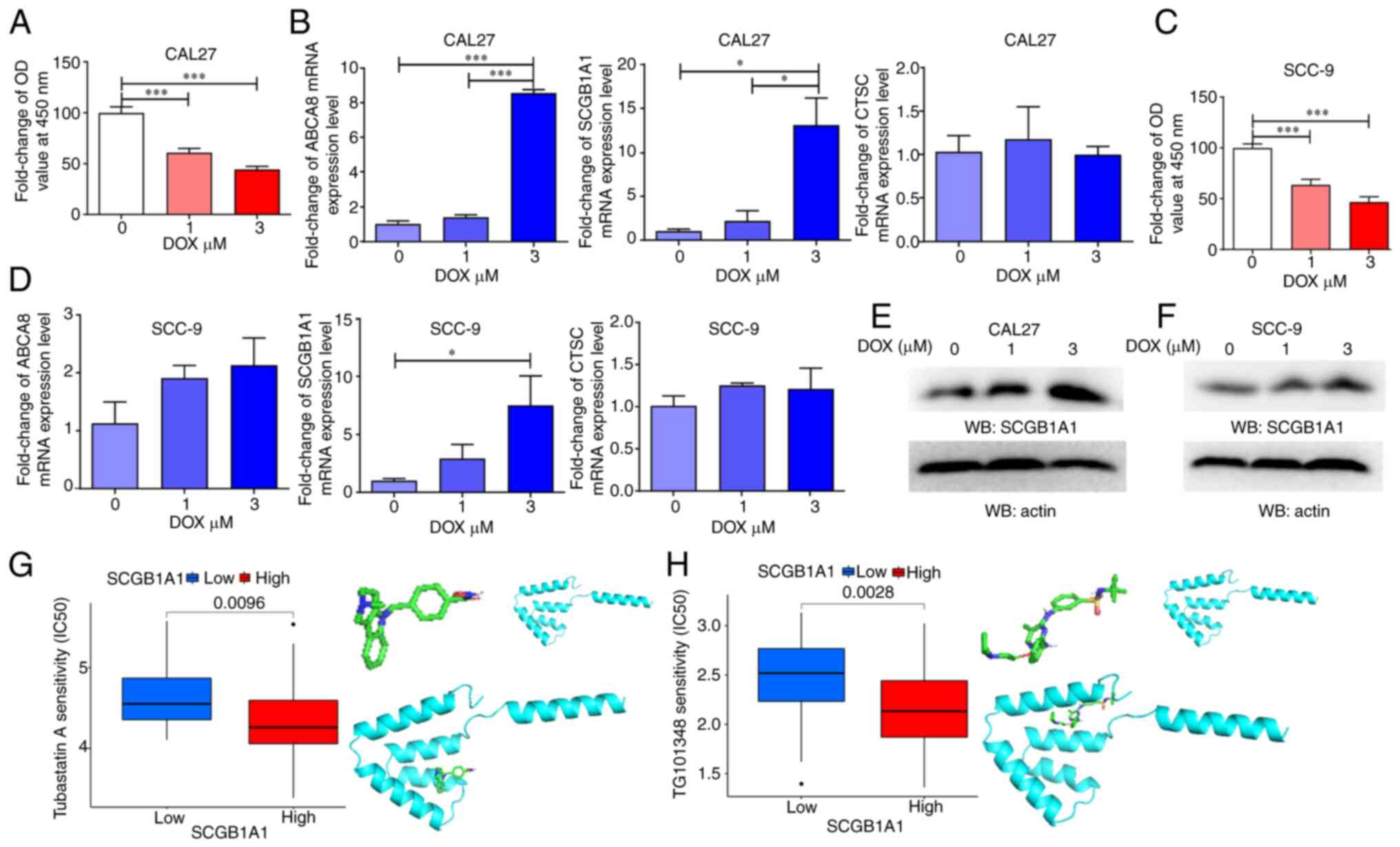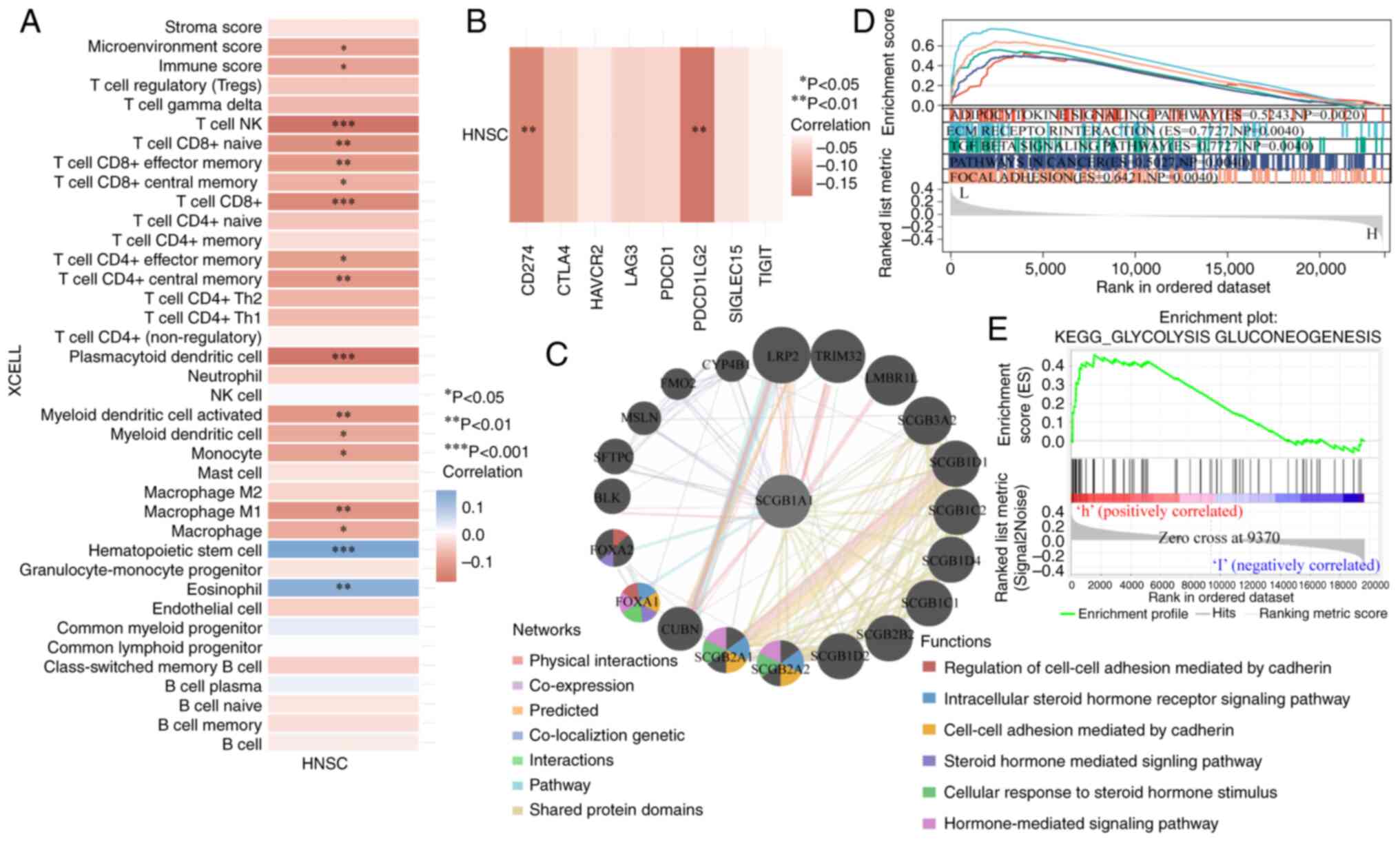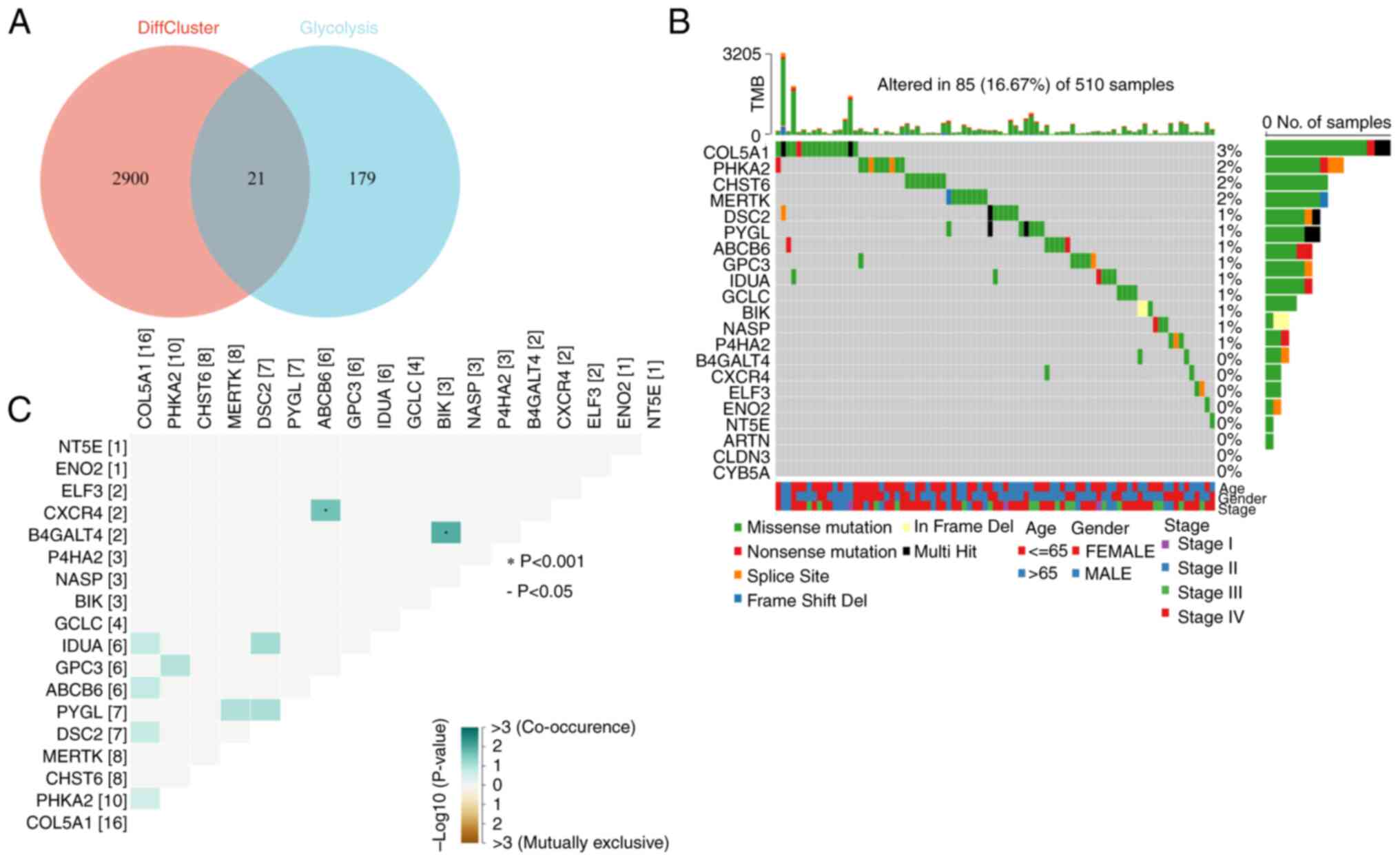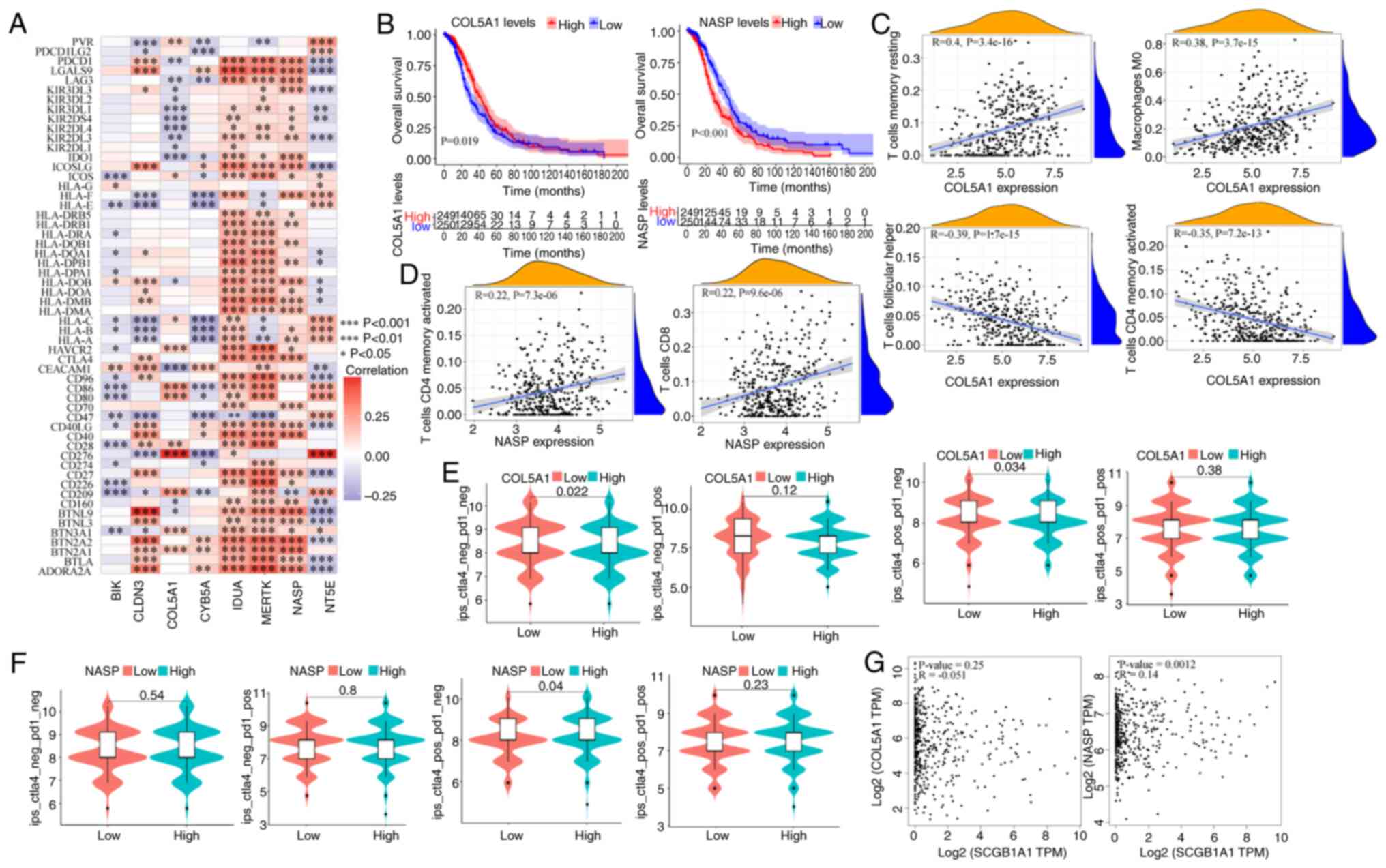|
1
|
Raj S, Kesari KK, Kumar A, Rathi B, Sharma
A, Gupta PK, Jha SK, Jha NK, Slama P, Roychoudhury S and Kumar D:
Molecular mechanism(s) of regulation(s) of c-MET/HGF signaling in
head and neck cancer. Mol Cancer. 21:312022. View Article : Google Scholar : PubMed/NCBI
|
|
2
|
Tang E, Lahmi L, Meillan N, Pietta G,
Albert S and Maingon P: Treatment strategy for distant synchronous
metastatic head and neck squamous cell carcinoma. Curr Oncol Rep.
21:1022019. View Article : Google Scholar : PubMed/NCBI
|
|
3
|
Chow LQM: Head and neck cancer. N Engl J
Med. 382:60–72. 2020. View Article : Google Scholar : PubMed/NCBI
|
|
4
|
Bray F, Ferlay J, Soerjomataram I, Siegel
RL, Torre LA and Jemal A: Global cancer statistics 2018: GLOBOCAN
estimates of incidence and mortality worldwide for 36 cancers in
185 countries. CA Cancer J Clin. 68:394–424. 2018. View Article : Google Scholar : PubMed/NCBI
|
|
5
|
Vahabi M, Blandino G and Di Agostino S:
MicroRNAs in head and neck squamous cell carcinoma: A possible
challenge as biomarkers, determinants for the choice of therapy and
targets for personalized molecular therapies. Transl Cancer Res.
10:3090–3110. 2021. View Article : Google Scholar : PubMed/NCBI
|
|
6
|
Global Burden of Disease Cancer
Collaboration, . Fitzmaurice C, Allen C, Barber RM, Barregard L,
Bhutta ZA, Brenner H, Dicker DJ, Chimed-Orchir O, Dandona R, et al:
Global, regional, and national cancer incidence, mortality, years
of life lost, years lived with disability, and disability-adjusted
life-years for 32 cancer groups, 1990 to 2015: A systematic
analysis for the global burden of disease study. JAMA Oncol.
3:524–548. 2017. View Article : Google Scholar : PubMed/NCBI
|
|
7
|
Hakim M, Billan S, Tisch U, Peng G,
Dvrokind I, Marom O, Abdah-Bortnyak R, Kuten A and Haick H:
Diagnosis of head-and-neck cancer from exhaled breath. Br J Cancer.
104:1649–1655. 2011. View Article : Google Scholar : PubMed/NCBI
|
|
8
|
Schötz U, Balzer V, Brandt FW, Ziemann F,
Subtil FSB, Rieckmann T, Köcher S, Engenhart-Cabillic R, Dikomey E,
Wittig A and Arenz A: Dual PI3K/mTOR inhibitor NVP-BEZ235 enhances
radiosensitivity of head and neck squamous cell carcinoma (HNSCC)
cell lines due to suppressed double-strand break (DSB) repair by
non-homologous end joining. Cancers (Basel). 12:4672020. View Article : Google Scholar : PubMed/NCBI
|
|
9
|
You Y, Tian Z, Du Z, Wu K, Xu G, Dai M,
Wang Y and Xiao M: M1-like tumor-associated macrophages cascade a
mesenchymal/stem-like phenotype of oral squamous cell carcinoma via
the IL6/Stat3/THBS1 feedback loop. J Exp Clin Cancer Res.
41:102022. View Article : Google Scholar : PubMed/NCBI
|
|
10
|
Tokheim CJ, Papadopoulos N, Kinzler KW,
Vogelstein B and Karchin R: Evaluating the evaluation of cancer
driver genes. Proc Natl Acad Sci USA. 113:143302016. View Article : Google Scholar : PubMed/NCBI
|
|
11
|
Andrea S, Paola M, Claudio P, Urbani G,
Allegretti M, Pellini R, Mehterov N, Ben-David U, Strano S, Bossi P
and Blandino G: Immunosignatures associated with TP53 status and
co-mutations classify prognostically head and neck cancer patients.
Mol Cancer. 22:1922023. View Article : Google Scholar
|
|
12
|
Kong W, Han Y, Gu H, Yang H and Zang Y:
TP53 mutation-associated immune infiltration and a novel risk score
model in HNSCC. Biochem Biophys Rep. 32:1013592022.PubMed/NCBI
|
|
13
|
El Baroudi M, Machiels JP and Schmitz S:
Expression of SESN1, UHRF1BP1, and miR-377-3p as prognostic markers
in mutated TP53 squamous cell carcinoma of the head and neck.
Cancer Biol Ther. 18:775–782. 2017. View Article : Google Scholar : PubMed/NCBI
|
|
14
|
Wei Z, Shen Y, Zhou C, Cao Y, Deng H and
Shen Z: CD3D: A prognostic biomarker associated with immune
infiltration and immunotherapeutic response in head and neck
squamous cell carcinoma. Bioengineered. 13:13784–13800. 2022.
View Article : Google Scholar : PubMed/NCBI
|
|
15
|
Chen Y, Yang J, Jin H, Wen W, Xu Y, Zhang
X and Wang Y: HtrA3: A promising prognostic biomarker and
therapeutic target for head and neck squamous cell carcinoma.
PeerJ. 11:e162372023. View Article : Google Scholar : PubMed/NCBI
|
|
16
|
Chen C, Méndez E, Houck J, Fan W,
Lohavanichbutr P, Doody D, Yueh B, Futran ND, Upton M, Farwell DG,
et al: Gene expression profiling identifies genes predictive of
oral squamous cell carcinoma. Cancer Epidemiol Biomarkers Prev.
17:2152–2162. 2008. View Article : Google Scholar : PubMed/NCBI
|
|
17
|
Zhang Y, Luo S, Jia Y and Zhang X:
Telomere maintenance mechanism dysregulation serves as an early
predictor of adjuvant therapy response and a potential therapeutic
target in human cancers. Int J Cancer. 151:313–327. 2022.
View Article : Google Scholar : PubMed/NCBI
|
|
18
|
Leemans CR, Snijders PJF and Brakenhoff
RH: The molecular landscape of head and neck cancer. Nat Rev
Cancer. 18:269–282. 2018. View Article : Google Scholar : PubMed/NCBI
|
|
19
|
Han D, Yu Z, Zhang H, Liu H, Wang B and
Qian D: Microenvironment-associated gene HSD11B1 may serve as a
prognostic biomarker in clear cell renal cell carcinoma: A study
based on TCGA, RT-qPCR, Western blotting, and immunohistochemistry.
Bioengineered. 12:10891–10904. 2021. View Article : Google Scholar : PubMed/NCBI
|
|
20
|
Ritchie ME, Phipson B, Wu D, Hu Y, Law CW,
Shi W and Smyth GK: limma powers differential expression analyses
for RNA-sequencing and microarray studies. Nucleic Acids Res.
43:e472015. View Article : Google Scholar : PubMed/NCBI
|
|
21
|
RStudio Team: RStudio: Integrated
Development for R. RStudio, Inc.; Boston, MA: 2015
|
|
22
|
Shippy DC and Ulland TK: Lipid metabolism
transcriptomics of murine microglia in Alzheimer's disease and
neuroinflammation. Sci Rep. 13:148002023. View Article : Google Scholar : PubMed/NCBI
|
|
23
|
Luo L, Zhu J, Guo Y and Li C: Mitophagy
and immune infiltration in vitiligo: Evidence from bioinformatics
analysis. Front Immunol. 14:11641242023. View Article : Google Scholar : PubMed/NCBI
|
|
24
|
Langfelder P and Horvath S: WGCNA: An R
package for weighted correlation network analysis. BMC
Bioinformatics. 9:5592008. View Article : Google Scholar : PubMed/NCBI
|
|
25
|
Liu B, Ma X and Ha W: Identification of
potential prognostic biomarkers associated with macrophage M2
infiltration in gastric cancer. Front Genet. 12:8274442022.
View Article : Google Scholar : PubMed/NCBI
|
|
26
|
Pei G, Chen L and Zhang W: WGCNA
application to proteomic and metabolomic data analysis. Methods
Enzymol. 585:135–158. 2017. View Article : Google Scholar : PubMed/NCBI
|
|
27
|
Wilkerson MD and Hayes DN:
ConsensusClusterPlus: A class discovery tool with confidence
assessments and item tracking. Bioinformatics. 26:1572–1573. 2010.
View Article : Google Scholar : PubMed/NCBI
|
|
28
|
Gao CH, Yu G and Cai P: ggVennDiagram: An
intuitive, easy-to-use, and highly customizable r package to
generate venn diagram. Front Genet. 12:7069072021. View Article : Google Scholar : PubMed/NCBI
|
|
29
|
Thomas PD: The gene ontology and the
meaning of biological function. Methods Mol Biol. 1446:15–24. 2017.
View Article : Google Scholar : PubMed/NCBI
|
|
30
|
Kanehisa M, Furumichi M, Tanabe M, Sato Y
and Morishima K: KEGG: New perspectives on genomes, pathways,
diseases and drugs. Nucleic Acids Res. 45:D353–D361. 2017.
View Article : Google Scholar : PubMed/NCBI
|
|
31
|
Liberzon A, Birger C, Thorvaldsdóttir H,
Ghandi M, Mesirov JP and Tamayo P: The molecular signatures
database (MSigDB) hallmark gene set collection. Cell Syst.
1:417–425. 2015. View Article : Google Scholar : PubMed/NCBI
|
|
32
|
Szklarczyk D, Gable AL, Lyon D, Junge A,
Wyder S, Huerta-Cepas J, Simonovic M, Doncheva NT, Morris JH, Bork
P, et al: STRING v11: Protein-protein association networks with
increased coverage, supporting functional discovery in genome-wide
experimental datasets. Nucleic Acids Res. 47:D607–D613. 2019.
View Article : Google Scholar : PubMed/NCBI
|
|
33
|
Shannon P, Markiel A, Ozier O, Baliga NS,
Wang JT, Ramage D, Amin N, Schwikowski B and Ideker T: Cytoscape: A
software environment for integrated models of biomolecular
interaction networks. Genome Res. 13:2498–2504. 2003. View Article : Google Scholar : PubMed/NCBI
|
|
34
|
Chin CH, Chen SH, Wu HH, Ho CW, Ko MT and
Lin CY: cytoHubba: Identifying hub objects and sub-networks from
complex interactome. BMC Syst Biol. 8 (Suppl 4):S112014. View Article : Google Scholar : PubMed/NCBI
|
|
35
|
Hess AS and Hess JR: Kaplan-Meier survival
curves. Transfusion. 60:670–672. 2020. View Article : Google Scholar : PubMed/NCBI
|
|
36
|
Goel MK, Khanna P and Kishore J:
Understanding survival analysis: Kaplan-Meier estimate. Int J
Ayurveda Res. 1:274–278. 2010. View Article : Google Scholar : PubMed/NCBI
|
|
37
|
Mu H, Wang Z, Zhang X, Qian D, Wang Y,
Jiang S, Liang S and Wang B: HCMV-encoded IE2 induces
anxiety-depression and cognitive impairment in UL122
genetically-modified mice. Int J Clin Exp Pathol. 12:4087–4095.
2019.PubMed/NCBI
|
|
38
|
Livak KJ and Schmittgen TD: Analysis of
relative gene expression data using real-time quantitative PCR and
the 2(−Delta Delta C(T)) method. Methods. 25:402–408. 2001.
View Article : Google Scholar : PubMed/NCBI
|
|
39
|
Geeleher P, Cox N and Huang RS:
pRRophetic: An R package for prediction of clinical
chemotherapeutic response from tumor gene expression levels. PLoS
One. 9:e1074682014. View Article : Google Scholar : PubMed/NCBI
|
|
40
|
Geeleher P, Cox NJ and Huang RS: Clinical
drug response can be predicted using baseline gene expression
levels and in vitro drug sensitivity in cell lines. Genome Biol.
15:R472014. View Article : Google Scholar : PubMed/NCBI
|
|
41
|
El-Hachem N, Haibe-Kains B, Khalil A,
Kobeissy FH and Nemer G: AutoDock and AutoDockTools for
protein-ligand docking: Beta-site amyloid precursor protein
cleaving enzyme 1(BACE1) as a case study. Methods Mol Biol.
1598:391–403. 2017. View Article : Google Scholar : PubMed/NCBI
|
|
42
|
Sugano-Nakamura N, Matoba K, Hirose M,
Bashiruddin NK, Matsunaga Y, Yamashita K, Hirata K, Yamamoto M,
Arimori T, Suga H and Takagi J: De novo Fc-based receptor
dimerizers differentially modulate PlexinB1 function. Structure.
30:1411–1423.e4. 2022. View Article : Google Scholar : PubMed/NCBI
|
|
43
|
Tao Q, Du J, Li X, Zeng J, Tan B, Xu J,
Lin W and Chen XL: Network pharmacology and molecular docking
analysis on molecular targets and mechanisms of Huashi Baidu
formula in the treatment of COVID-19. Drug Dev Ind Pharm.
46:1345–1353. 2020. View Article : Google Scholar : PubMed/NCBI
|
|
44
|
Zeng D, Li M, Zhou R, Zhang J, Sun H, Shi
M, Bin J, Liao Y, Rao J and Liao W: Tumor microenvironment
characterization in gastric cancer identifies prognostic and
immunotherapeutically relevant gene signatures. Cancer Immunol Res.
7:737–750. 2019. View Article : Google Scholar : PubMed/NCBI
|
|
45
|
Sturm G, Finotello F, Petitprez F, Zhang
JD, Baumbach J, Fridman WH, List M and Aneichyk T: Comprehensive
evaluation of transcriptome-based cell-type quantification methods
for immuno-oncology. Bioinformatics. 35:i436–i445. 2019. View Article : Google Scholar : PubMed/NCBI
|
|
46
|
Li B, Severson E, Pignon JC, Zhao H, Li T,
Novak J, Jiang P, Shen H, Aster JC, Rodig S, et al: Comprehensive
analyses of tumor immunity: Implications for cancer immunotherapy.
Genome Biol. 17:1742016. View Article : Google Scholar : PubMed/NCBI
|
|
47
|
Aran D, Hu Z and Butte AJ: xCell:
Digitally portraying the tissue cellular heterogeneity landscape.
Genome Biol. 18:2202017. View Article : Google Scholar : PubMed/NCBI
|
|
48
|
Li T, Fu J, Zeng Z, Cohen D, Li J, Chen Q,
Li B and Liu XS: TIMER2.0 for analysis of tumor-infiltrating immune
cells. Nucleic Acids Res. 48:W509–W514. 2020. View Article : Google Scholar : PubMed/NCBI
|
|
49
|
Wang J, Sun J, Liu LN, Flies DB, Nie X,
Toki M, Zhang J, Song C, Zarr M, Zhou X, et al: Siglec-15 as an
immune suppressor and potential target for normalization cancer
immunotherapy. Nat Med. 25:656–666. 2019. View Article : Google Scholar : PubMed/NCBI
|
|
50
|
Frost FG, Cherukuri PF, Milanovich S and
Boerkoel CF: Pan-cancer RNA-seq data stratifies tumours by some
hallmarks of cancer. J Cell Mol Med. 24:418–430. 2020. View Article : Google Scholar : PubMed/NCBI
|
|
51
|
Izzi V, Davis MN and Naba A: Pan-cancer
analysis of the genomic alterations and mutations of the matrisome.
Cancers (Basel). 12:20462020. View Article : Google Scholar : PubMed/NCBI
|
|
52
|
Zhang Q, Huang R, Hu H, Yu L, Tang Q, Tao
Y, Liu Z, Li J and Wang G: Integrative analysis of
hypoxia-associated signature in pan-cancer. iScience.
23:1014602020. View Article : Google Scholar : PubMed/NCBI
|
|
53
|
Franz M, Rodriguez H, Lopes C, Zuberi K,
Montojo J, Bader GD and Morris Q: GeneMANIA update 2018. Nucleic
Acids Res. 46:W60–W64. 2018. View Article : Google Scholar : PubMed/NCBI
|
|
54
|
Mayakonda A, Lin DC, Assenov Y, Plass C
and Koeffler HP: Maftools: Efficient and comprehensive analysis of
somatic variants in cancer. Genome Res. 28:1747–1756. 2018.
View Article : Google Scholar : PubMed/NCBI
|
|
55
|
Jiang L and Liu J: Immunological effect of
tyrosine kinase inhibitors on the tumor immune environment in
non-small cell lung cancer. Oncol Lett. 23:1652022. View Article : Google Scholar : PubMed/NCBI
|
|
56
|
Hu FF, Liu CJ, Liu LL, Zhang Q and Guo AY:
Expression profile of immune checkpoint genes and their roles in
predicting immunotherapy response. Brief Bioinform. 22:bbaa1762021.
View Article : Google Scholar : PubMed/NCBI
|
|
57
|
Barsouk A, Aluru JS, Rawla P, Saginala K
and Barsouk A: Epidemiology, risk factors, and prevention of head
and neck squamous cell carcinoma. Med Sci (Basel).
11:422023.PubMed/NCBI
|
|
58
|
Trivedi S, Sun L and Aggarwal C:
Immunotherapy for head and neck cancer. Hematol Oncol Clin North
Am. 35:1021–1037. 2021. View Article : Google Scholar : PubMed/NCBI
|
|
59
|
Li XX, Peng T, Gao J, Feng JG, Wu DD, Yang
T, Zhong L, Fu WP and Sun C: Allele-specific expression identified
rs2509956 as a novel long-distance cis-regulatory SNP for SCGB1A1,
an important gene for multiple pulmonary diseases. Am J Physiol
Lung Cell Mol Physiol. 317:L456–L463. 2019. View Article : Google Scholar : PubMed/NCBI
|
|
60
|
Xu M, Yang W, Wang X and Nayak DK: Lung
secretoglobin Scgb1a1 influences alveolar macrophage-mediated
inflammation and immunity. Front Immunol. 11:5843102020. View Article : Google Scholar : PubMed/NCBI
|
|
61
|
Yu Y, Liu JY, Yang HJ, Luo XQ, Gao XP,
Huang XX, Tang AX, Mary Cheng HY, Liu WC and Zhang P: Circadian
disruption during fetal development promotes pathological cardiac
remodeling in male mice. iScience. 27:1090082024. View Article : Google Scholar : PubMed/NCBI
|
|
62
|
Liu Y, Yu HJ, Wang N, Zhang YN, Huang SK,
Cui YH and Liu Z: Clara cell 10-kDa protein inhibits T(H)17
responses through modulating dendritic cells in the setting of
allergic rhinitis. J Allergy Clin Immunol. 131:387–394.e1-12. 2013.
View Article : Google Scholar : PubMed/NCBI
|
|
63
|
Linnoila RI, Szabo E, DeMayo F, Witschi H,
Sabourin C and Malkinson A: The role of CC10 in pulmonary
carcinogenesis: From a marker to tumor suppression. Ann N Y Acad
Sci. 923:249–267. 2000. View Article : Google Scholar : PubMed/NCBI
|
|
64
|
Hicks SM, Vassallo JD, Dieter MZ, Lewis
CL, Whiteley LO, Fix AS and Lehman-McKeeman LD: Immunohistochemical
analysis of Clara cell secretory protein expression in a transgenic
model of mouse lung carcinogenesis. Toxicology. 187:217–228. 2003.
View Article : Google Scholar : PubMed/NCBI
|
|
65
|
Pilon AL: Rationale for the development of
recombinant human CC10 as a therapeutic for inflammatory and
fibrotic disease. Ann N Y Acad Sci. 923:280–299. 2000. View Article : Google Scholar : PubMed/NCBI
|
|
66
|
Mirlekar B: Tumor promoting roles of
IL-10, TGF-β, IL-4, and IL-35: Its implications in cancer
immunotherapy. SAGE Open Med. 10:205031212110690122022. View Article : Google Scholar : PubMed/NCBI
|
|
67
|
Lu J, Linares B, Xu Z and Rui YN:
Mechanisms of FA-phagy, a new form of selective
autophagy/organellophagy. Front Cell Dev Biol. 9:7991232021.
View Article : Google Scholar : PubMed/NCBI
|
|
68
|
Wu L, Jin Y, Zhao X, Tang K, Zhao Y, Tong
L, Yu X, Xiong K, Luo C, Zhu J, et al: Tumor aerobic glycolysis
confers immune evasion through modulating sensitivity to T
cell-mediated bystander killing via TNF-α. Cell Metab.
35:1580–1596.e9. 2023. View Article : Google Scholar : PubMed/NCBI
|
|
69
|
Yang FM, Chang HM and Yeh ETH: Regulation
of TLR4 signaling through the TRAF6/sNASP axis by reversible
phosphorylation mediated by CK2 and PP4. Proc Natl Acad Sci USA.
118:e21070441182021. View Article : Google Scholar : PubMed/NCBI
|
|
70
|
Economopoulou P, Agelaki S, Perisanidis C,
Giotakis EI and Psyrri A: The promise of immunotherapy in head and
neck squamous cell carcinoma. Ann Oncol. 27:1675–1685. 2016.
View Article : Google Scholar : PubMed/NCBI
|



